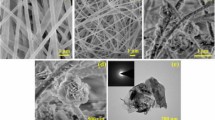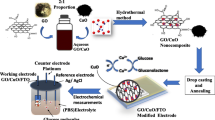Abstract
Porous CuO–CdO nanofibers with mean diameter of 463 nm and high surface-to-volume ratio were prepared by impregnating electrospun carboxylic-functionalized poly(arylene ether ketone) (PCA-PAEK) nanofibrous webs with metal acetate solution and subsequent calcination. The special morphology was demonstrated to be decided by ion exchange reaction between metal ions and functional groups on polymer. TGA and EDX analysis confirmed that Cd2+ was more readily to react with PCA-PAEK than Cu2+, and the amount of Cu2+ can be decreased by overloading of Cd2+, leading to the degradation of sensing performance. FT-IR proved the existence of the ion exchange reaction and demonstrated the products were highly pure CuO–CdO compounds with EDX and XRD spectra. The products detailedly investigated for direct electrocatalytic oxidation of glucose evaluated cyclic voltammetry and chronoamperometry. CuO–CdO nanofibers modified electrodes exhibited superiorities of good anti-interference, low detection limit and fast response of glucose, attributing to the enhanced conductivity brought by CdO, good electrocatalytic activity brought by CuO and large surface area brought by porous structure. The simple strategy of electrospinning porous nanofibers using PCA-PAEK as templates and combined CuO and CdO with good electrooxidation glucose functions opens a new route to generate novel conductive metal oxide hybrid nanofibers applied for glucose enzymeless sensors.








Similar content being viewed by others
References
Hwang B, Kim M, Cho SM, Becker S, Kim YH, Kim H (2017) Embedded silver-nanowire electrode in an acrylic polymer-silicate nanoparticle composite for highly robust flexible devices. J Appl Polym Sci 134:45203. https://doi.org/10.1002/app.45203
Liu M, Cheng Z, Yan J, Qiang L, Ru X, Liu F, Ding D, Li J (2013) Preparation and characterization of TiO2 nanofibers via using polylactic acid as template. J Appl Polym Sci 128:1095–1100
Liu Y, Zhang B, Luo L, Chen X, Wang Z, Wu E, Su DS, Huang W (2015) TiO2/Cu2O core/ultrathin shell nanorods as efficient and stable photocatalysts for water reduction. Angew Chem Int Edit 54:15260–15265
Ding H, Ma Y (2015) Theoretical and computational investigations of nanoparticle–biomembrane interactions in cellular delivery. Small 11:1055–1071
Zhang L, Wang X, Xu W, Zhang Y, Li Q, Bradford PD, Zhu Y (2015) Strong and conductive dry carbon nanotube films by microcombing. Small 11:3830–3836
Wang W, Li Z, Zheng W, Dong B, Li S, Wang C (2010) A novel non-enzymatic glucose sensor based on nickel (II) oxide electrospun nanofibers. J Nanosci Nanotechno 10:7537–7540
Islam AB, Islam SK, Rahman T (2010) A highly selective mediator less glucose detector employing vertically aligned carbon nanofiber (VACNF). In: Ieee sensors 2010 conference, pp 42–46
Wang J (2008) Electrochemical glucose biosensors. Chem Rev 108:814–825
Terry LA, White SF, Tigwell LJ (2005) The application of biosensors to fresh produce and the wider food industry. J Agric Food Chem 53:1309–1316
Lee DY, Kafi AKF, Choi WS, Park SH, Kwon YS (2008) Glucose sensor based on glucose oxidase-lipid LB film immobilized in prussian blue layer. J Nanosci Nanotechnol 8:4543–4547
Manesh KM, Kim JH, Santhosh P, Gopalan AY, Lee KP, Kang HD (2007) Fabrication of a gold nanoparticles decorated carbon nanotubes based novel modified electrode for the electrochemical detection of glucose. J Nanosci Nanotechnol 7:3365–3372
Wilson R, Turner APF (1992) Glucose oxidase: an ideal enzyme. Biosens Bioelectron 7:165–185
Senthamizhan A, Balusamy B, Uyar T (2016) Glucose sensors based on electrospun nanofibers: a review. Anal Bioanal Chem 408:1285–1306
Li J, Hu H, Li H, Yao C (2017) Recent developments in electrochemical sensors based on nanomaterials for determining glucose and its byproduct H2O2. J Mater Sci 52:10455–10469. https://doi.org/10.1007/s10853-017-1221-4
Liu H, Su X, Tian X, Huang Z, Song W, Zhao J (2006) Preparation and electrocatalytic performance of functionalized copper-based nanoparticles supported on the gold surface. Electroanalysis 18:2055–2060
Zhou L, Gan T, Zheng DY, Yan JJ, Hu CG, Hu SS (2012) High-density gold nanoparticles on multi-walled carbon nanotube films: a sensitive electrochemical nonenzymatic platform of glucose. J Exp Nanosci 7:263–273
Sun YP, Buck H, Mallouk TE (2001) Combinatorial discovery of alloy electrocatalysts for amperometric glucose sensors. Anal Chem 73:1599–1604
Liu YX, Ding Y, Zhang YC, Lei Y (2012) Pt-Au nanocorals, Pt nanofibers and Au microparticles prepared by electrospinning and calcination for nonenzymatic glucose sensing in neutral and alkaline environment. Sens Actuators B 171:954–961
Sahay R, Kumar PS, Aravindan V, Sundaramurthy J, Ling WC, Mhaisalkar SG, Ramakrishna S, Madhavi S (2012) High aspect ratio electrospun CuO nanofibers as anode material for lithium-ion batteries with superior cycleability. J Phys Chem C 116:18087–18092
Zhang Y, Liu Y, Su L, Zhang Z, Huo D, Hou C, Lei Y (2014) CuO nanowires based sensitive and selective non-enzymatic glucose detection. Sens Actuators B 191:86–93
Kanjwal MA, Barakat NAM, Sheikh FA, Kim HY (2010) Electronic characterization and photocatalytic properties of TiO2/CdO electrospun nanofibers. J Mater Sci 45:1272–1279. https://doi.org/10.1007/s10853-009-4078-3
Wang SH, Yang SH (2001) Spectroscopic characterization of the copper sulphide core/shell nanowires. Mater Sci Eng C 16:37–40
Ding Y, Wang Y, Zhang LC, Zhang H, Lei Y (2012) Preparation, characterization and application of novel conductive NiO–CdO nanofibers with dislocation feature. J Mater Chem 22:980–986
Savva I, Kalogirou AS, Chatzinicolaou A, Papaphilippou P, Pantelidou A, Vasile E, Vasile E, Koutentis PA, Christoforou TK (2014) PVP-crosslinked electrospun membranes with embedded Pd and Cu2O nanoparticles as effective heterogeneous catalytic supports. RSC Adv 4:44911–44921
Deshawar D, Chokshi P (2017) Stability analysis of an electrospinning jet of a polymeric fluid. Polymer 131:34–49
Wittmer CR, Hebraud A, Nedjari S, Schlatter G (2014) Well-organized 3D nanofibrous composite constructs using cooperative effects between electrospinning and electrospraying. Polymer 55:5781–5787
Dai Y, Liu W, Formo E, Sun Y, Xia Y (2011) Ceramic nanofibers fabricated by electrospinning and their applications in catalysis, environmental science, and energy technology. Polym Adv Technol 22:326–338
Dersch R, Steinhart M, Boudriot U, Greiner A, Wendorff JH (2005) Nanoprocessing of polymers: applications in medicine, sensors, catalysis, photonics. Polym Adv Technol 16:276–282
Liu M, Wang Y, Cheng Z, Zhang M, Hu M, Li J (2015) Electrospun carboxylic-functionalized poly(arylene ether ketone) ultrafine fibers: optimization, characterization, and water absorption behavior. High Perform Polym 27:939–949
Sarah LS, David WW (2006) Biomimetic synthesis of titanium dioxide utilizing the R5 peptide derived from cylindrotheca fusiformis. Chem Mater 18:3108–3113
Nuansing WW, Ninmuang S, Jarernboon W, Maensiria S, Seraphin S (2006) Structural characterization and morphology of electrospun TiO2 nanofibers. Mater Sci Eng, B 131:147–155
Ding B, Kim CK, Kim HY, Seo MK, Park SJ (2004) Titanium dioxide nanofibers prepared by using electrospinning method. Fiber Polym 5:105–109
Zheng JY, Pang JB, Qiu KY, Wei Y (2001) Synthesis of mesoporous titanium dioxide materials by using a mixture of organic compounds as a non-surfactant template. J Mater Chem 11:3367–3372
Zheng JY, Qiu KY, Feng QW, Xu JG, Wei Y (2000) Sol–Gel synthesis of mesoporous titania using nonsurfactant organic compounds as templates. Mol Cryst Liq Cryst 354:183–194
Liu M, Wang Y, Cheng Z, Zhang M, Hu M, Li J (2014) Electrospun Mn2O3 nanowrinkles and Mn3O4 nanorods: morphology and catalytic application. Appl Surf Sci 313:360–367
Yang J, Zeng JH, Yu SH, Yang L, Zhou G, Qian Y (2000) Formation process of CdS nanorods via solvothermal route. Chem Mater 12:3259–3263
Liu M, Song L, Wang Y, Cheng Z, Li J (2014) High-effective preparation of ultrafine poly-(L-lactide-co-ε-caprolactone-diOH) fibers containing silver nanoparticles. High Perform Polym 26:483–487
Liu M, Wang Y, Cheng Z, Song L, Zhang M, Hu M, Li J (2014) Function of NaOH hydrolysis in electrospinning ZnO nanofibers via using polylactide as templates. Mater Sci Eng B 187:89–95
Zhang Y (2016) Synthesis and photoluminescence study of zinc sulfide–poly(arylene ether ketone) nanocomposite materials. High Perform Polym 28:198–205
Guan H, Shao C, Chen B, Gong J, Yang X (2003) A novel method for making CuO superfine fibres via an electrospinning technique. Inorg Chem Commun 6:1409–1411
Bazargan AM, Fateminia SMA, Ganji ME, Bahrevar MA (2009) Electrospinning preparation and characterization of cadmium oxide nanofibers. Chem Eng J 155:523–527
Wang W, Zhang L, Tong S, Li X, Song W (2009) Three-dimensional network films of electrospun copper oxide nanofibers for glucose determination. Biosens Bioelectron 25:708–714
Tian K, Prestgard M, Tiwari A (2014) A review of recent advances in nonenzymatic glucose sensors. Mat Sci Eng C 41:100–118
Author information
Authors and Affiliations
Corresponding author
Ethics declarations
Conflict of interest
The authors declare that there is no conflict of interests regarding the publication of this article.
Rights and permissions
About this article
Cite this article
Liu, M., Wang, Y. & Lu, D. Sensitive and selective non-enzymatic glucose detection using electrospun porous CuO–CdO composite nanofibers. J Mater Sci 54, 3354–3367 (2019). https://doi.org/10.1007/s10853-018-3034-5
Received:
Accepted:
Published:
Issue Date:
DOI: https://doi.org/10.1007/s10853-018-3034-5




